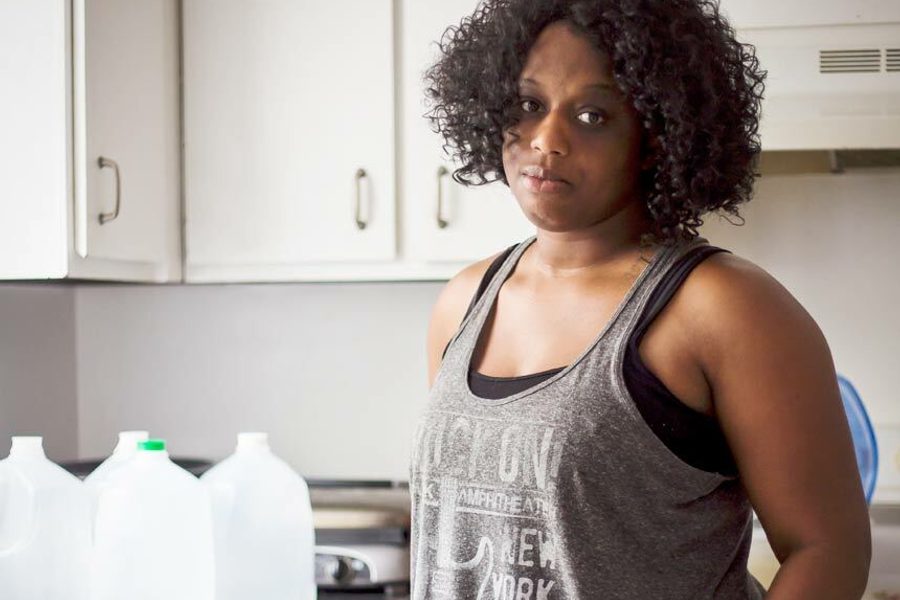
Anoa Changa is wary of the water. “I won’t cook with it or even brush my teeth with it,” she says.
In Charleston, West Virginia, where Changa lives, officials say the water is safe again despite the January spill of 10,000 gallons of MCHM (4-methylcyclohexanemethanol, a compound used to clean coal) that seeped into the river and tainted the local water supply. Even so, Changa has continued filling her family’s refrigerator (and until mid-March, their tub) with gallon after gallon of store-bought water.
Each 99-cent jug further strains a budget already stretched thin by the cost of raising two children as a single mother with student-loan debt. Each gallon adds to the $700 Changa has already spent due to the spill, without any government reimbursement. So far, Changa has forked out $300 on bottled water, $250 on prepared foods, and $150 for gas to leave town and shower at the homes of friends. “Every penny will be worth it as long as we don’t get sick again,” says Changa, referring to the breathing problems, headaches and upset stomachs that she, her 10-year-old son and her 12-year-old daughter suffered in the spill’s immediate wake.
At press time in early May, many Charleston residents were, like Changa, still bathing, scrubbing their dishes or washing their clothes using nothing but bottled water. Though MCHM levels have supposedly dropped to those deemed “safe” by the Centers for Disease Control and Prevention (CDC), residents know that the government has done only limited research on MCHM’s health dangers. While the American Association of Poison Control Centers has determined that MCHM can spur vomiting, dizziness, headaches, diarrhea and skin irritation, authorities have yet to establish where MCHM accumulates in the human body and whether it is carcinogenic. And the CDC’s safety thresholds only take into account the cocktail’s main ingredient, 4-MCHM. Researchers have yet to examine the health effects of its other five ingredients in detail.
“Until we know more, I’m not taking any chances,” Changa says.
Charleston residents are baffled— and indignant — that MCHM leached into their water so easily. (“We want answers,” read one placard at a protest at the state capitol building. “Prosecute the poisoners,” read another.) But the spill in West Virginia was not a freak occurrence. The United States sees more than its share of industrial accidents. Consider the 2008 spill of 1 billion gallons of coal-ash slurry in Kingston, Tennessee, which coated the surrounding land in a 6-foot-deep layer of sludge that cost an estimated $1.2 billion to clean up. Or the 2013 ammonium nitrate explosion at a West, Texas, fertilizer plant. That catastrophe — at a facility that federal inspectors had not visited for 27 years — injured more than 300 people and claimed 15 lives.
No single government agency is responsible for tracking and verifying chemical spills, so their exact number is unknown. But the National Oceanic and Atmospheric Administration (NOAA) puts the figure at “thousands” each year, while Bloomberg Businessweek counted 3,885 in 2013 and CBS identified more than 6,500 in 2010.
When chemicals like MCHM are spilled, say experts, it adds to the stew of synthetic substances already polluting our environment. The CDC has found that on average, U.S. citizens have detectable levels of 212 synthetic chemicals in their blood or urine. And experts say it’s no surprise that breast cancer and diabetes, both of which are linked to pollution, have doubled in incidence over the past 50 years.
Whether health problems are linked to accidents like the MCHM spill or to everyday exposure to pollution, experts say U.S. regulatory lapses are in part to blame. “This isn’t just about West Virginia,” says Rahul Gupta, head of the Kanawha-Charleston Health Department. “This is a national problem. From poor chemical storage to loose regulations, from aging infrastructure to lax water security, what happened in Charleston was a recipe for other health catastrophes that are also just waiting to happen.”
Stranger to blue water
The MCHM spill started with Freedom Industries, a wholesale provider of mining-industry chemicals that control road dust, keep coal from freezing and prepare it for burning. Though the company changed ownership just 10 days before the spill, it was cofounded and run for decades by a wealthy racketeer, Carl Kennedy II, who had earned both a felony conviction for conspiring to sell cocaine and a 40-month prison sentence for tax fraud. The company had repeatedly failed to file mandatory leak-prevention plans with the state Department of Environmental Protection — an oversight that the agency then failed to penalize. For years, Charleston residents living near Freedom Industries’ “tank farm” on the banks of the Elk River had complained of a licorice smell. In response, state authorities had made five visits to the facility since 2001, but they didn’t find any serious violations.
Just as Freedom Industries was a disaster in the making, so too were the environmental policies that allowed the MCHM spill to occur. For decades, chemical companies have cozied up to policymakers and successfully lobbied them to limit industry oversight. Eastman Chemical Company, which makes MCHM, has its own political action committee and has spent $288,314 in 2013-2014 campaign contributions to date. “The vast majority of that money went to Republicans who have a history of being friendly to business groups and hostile to regulation,” says Russ Choma, a spokesperson for the Center for Responsive Politics (CRP), a Washington, D.C., nonprofit that tracks money in politics. CRP has evidence that in 2005, someone from Freedom Industries gave $500 to the Republican National Committee, while in 2013, another company affiliate donated $5,000 to House Speaker John Boehner (R-Ohio). At a press conference in the wake of the MCHM spill, Boehner balked at the mention of chemical-industry reform, declaring that “we have enough regulations on the books.”
“Federal policy holds chemical manufacturers innocent until they are proven guilty,” says Heather White, executive director of the nonprofit Environmental Working Group in D.C. “And it’s especially lax when it comes to regulating older substances. MCHM is one of 64,000 chemicals that the U.S. grandfathered into the 1976 Toxic Substances Control Act, allowing companies to make, sell and distribute these chemicals without first proving they were safe to human health.”
In the years leading up to the spill, environmental deregulation had become a notorious problem in West Virginia. The state’s failure to uphold the 1972 Clean Water Act and the 1974 Safe Drinking Water Act had become so egregious that in 2009, activists unsuccessfully petitioned the federal government to take over enforcement of these regulations within the state’s borders. In 2011, West Virginia officials ignored the U.S. Chemical Safety Board’s call to create a new “hazardous chemical release prevention program.” That same year, a study published in the journal Science found that the vast majority of streams near mining sites in West Virginia had elevated levels of selenium, a mining by-product that can trigger neurological problems and cause people’s fingernails to fall out.
Charleston itself is rife with pollution. Locals call the surrounding region “Chemical Valley” because refining plants loom over the landscape. But, largely for socioeconomic reasons, there is little public pushback against the grey fumes that pour from the blackened smokestacks here. The median annual per capita income in Charleston hovers below $35,000. (West Virginia has the fourth-lowest per capita income of any state, and Walmart is its largest private employer.) Charleston residents can beat that average if they secure work in the mining and chemical industries for which their state is renowned. “It’s a complicated issue here because the same things affecting your health and well-being are the very same things that put food on your table,” says Chemical Valley native Maya Nye, who heads the local nonprofit People Concerned About Chemical Safety. Nye became an environmental activist after a 1992 explosion killed an employee at a West Virginia Union Carbide plant a mile from her home. “In this community, public health and safety take a back seat to ever-widening profit margins,” she says.
A Jäger bomb
MCHM seeped into Charleston’s water supply in the depths of a long, bleak winter. Along the banks of the frozen Elk River, at the Freedom Industries facility on the northeast side of town, stood a 76-year-old storage tank with a cracked containment wall that had been slated for repairs since some time in 2013. Two holes in the tank began releasing a trickle of mining chemicals. These toxins oozed into the ground and eventually into the river, flowing a mile-and-a-half south toward the largest water-treatment plant in West Virginia and tainting the water supply of 300,000 Charleston residents. The spill contained not just MCHM, but also PPH (odorless polyglycol ethers, solvents that reduce other chemicals’ viscosity, that accounted for 5 percent of the leak by volume, and that, like MCHM, have not had their health impact studied in great depth). “Those of us living nearby smelled the leak for days before authorities found it,” says Kevin Kidd, a local musician. “It smelled like a Jäger bomb — a cocktail of Jägermeister and beer or Red Bull energy drink. It was a sickly, awful licorice smell. And it was powerful.” Responding to residents’ complaints, state inspectors drove out to Freedom Industries around 11 a.m. on Thursday, January 9. An hour later, facility employees called a hotline to officially report the leak. But it wasn’t until 6 p.m. that West Virginia Gov. Earl Ray Tomblin, a Democrat, announced a local ban on the use of tap water for drinking, cooking and bathing.
The next day, President Barack Obama declared a federal state of emergency. National Guard troops sped into Charleston bearing bottled water by the truckload. Authorities shut down local schools, businesses and restaurants. The FBI launched a criminal investigation. And more than 4,000 calls from Charleston residents started flooding the lines of the Kanawha-Charleston Board of Health.
Glued to their televisions, radios and laptops, affected locals listened, watched and worried as recovery took a few steps forward, then just as many steps back.
“The day of the spill, we moved as quickly as we could, but it took hours to find a way to test how much MCHM and PPH were in the water,” says Gupta of the Kanawha-Charleston Health Department. “For MCHM, all we had to go on regarding health effects were 15- to 20-year-old studies that included just five to 30 rats per study. For PPH, we had almost no information whatsoever.”
Based on what limited data they could find, health officials announced within a week of the spill that levels of MCHM in the river and in Charleston homes were now testing below one part per million, the level the CDC said was safe. Later, Gupta says, the CDC revealed that this was only the “short-term” safety threshold, for less than 14 days of exposure. Moreover, “MCHM ‘safety’ had only been established for drinking, not for dermal exposure or inhalation,” says Nye. “People could still inhale the water vapors. And they could still smell that licorice smell.”
West Virginia American Water, the local water company, divided Charleston into zones, and asked residents to “flush” their pipes zone by zone. “We let all our taps run for 20 minutes, and ran dishwashers and washing machines,” says Changa. “But we still smelled licorice or got sick. So we kept reflushing our pipes.”
Many Charleston residents were baffled when authorities gave the “all clear” to use local tap water on January 18, just nine days after the spill, even though the odor and the illnesses persisted. (Changa, for one, developed bronchitis and asthma for the first time in her life.) Pregnant women were especially confused: In subsequent weeks, officials told them to shun tap water, then reversed course and announced that the water posed no more danger to them or to their unborn infants than it did to anyone else.
Though West Virginia American Water could give its customers no concrete assurance that their water was safe, it continued to bill them as usual (though it did offer a credit of $10.29 per customer to offset the cost of using 1,000 gallons of water to flush the pipes in homes). In early February, irate customers marched on the company’s offices and presented “bills” demanding payment for personal costs related to water contamination. “People were stinky, and they were angry,” says Kidd, who, along with his neighbor T.J. King, wrote a mock anthem called “The Aquapocalypse” that became a hit on local radio.
By February, problems still persisted. Local schools that had been reopened were now being dismissed early when students complained of lightheadedness and burning eyes and noses. One teacher reportedly fainted on the job. Charleston restaurants reopened but remained nearly empty as people left town to eat many of their meals. Grocery and convenience store clerks scrambled to keep store shelves stocked with enough bottled water. Because authorities wouldn’t test for water safety in the majority of individual homes, residents paid out of their own pockets, sometimes repeatedly, for $200 to $1,000 analyses (although many locals, including Changa, could not afford these tests).
In the end, more than 540 people in Charleston reported health problems linked to MCHM exposure. They lost their well-being, their emergency savings funds — and their faith in public authorities. Surveys show that by March 1 — nine weeks after the water ban was lifted — only 5 percent of residents were drinking tap water. “By early April, only a third of residents would drink it,” says Gupta, who waited nearly two months to resume drinking the water, and whose two children are reluctant to drink it to this day.
Regulators to the rescue?
One positive outcome of the spill — besides big profits for bottled-water companies — has been West Virginia’s recent passage of Senate Bill 373, which requires that chemical storage containers be better inventoried and industry water use more carefully tracked.
Despite the success of this “spill bill,” health advocates say they face uphill battles in their other quests for justice and policy reform.
The loss to businesses during the water ban was estimated at $19 million per day. The spill racked up more than $200,000 in bills for the Kanawha-Charleston Health Department alone, which, along with the city of Charleston, is suing Freedom Industries for damages. All told, the spill triggered more than two dozen lawsuits. But peoples’ chances of regaining the money they lost — and using it for long-term recovery — have been compromised by Freedom Industries’ January 17 filing of Chapter 11 bankruptcy. Meanwhile, a federal grand jury investigation and a Chemical Safety Board probe are underway, but may take months to reach conclusions.
Gov. Tomblin is lobbying for the launch of the “West Virginia Testing Assessment Project” or WV TAP, which would continue to monitor MCHM contamination in nine affected counties. But the proposed project’s scope is limited: It would not test the majority of individual homes, relying instead on water sampling to assess the probability that a home in any given area had tainted water. And while the state has earmarked $650,000 for the WV TAP project, federal funding is still needed.
The CDC has yet to launch epidemiological and toxicological studies of MCHM and PPH. “We have limited studies on short-term exposure to MCHM and PPH,” says Gupta. “But we need complete studies that examine long-term exposure.” In response to Gupta’s claims, CDC spokesperson Bernadette Burden says, “We do not see indications that long-term health effects are a likely outcome of the Elk River chemical spill.” Burden says the CDC monitored short-term effects and conducted a door-to-door survey of Charleston households, but at press time the results were still under analysis and had not been released.
Congressional efforts are hitting roadblocks, too. Two weeks after the spill, West Virginia Democrats Sen. Joe Manchin and Sen. Jay Rockefeller introduced the Chemical Safety and Drinking Water Protection Act of 2014, which would make above-ground storage tanks more secure. But their bill has been weakened to appease politicians who are friendly with the chemical industry (the revised legislation exempts some types of storage tanks from inspection). Even if this watered-down bill does reach the Senate floor, it may never have the chance to become law. Its companion bill in the House attracted no cosponsors and has been languishing in congressional committees since West Virginia Republican Rep. Shelley Moore Capito introduced it in February.
Despite the political pressure wielded by America’s 22,000 chemical companies — including pro-industry lobbyists such as the American Chemistry Council, which has a reported annual budget of $100 million — health advocates hold out hope that the setbacks suffered in West Virginia might finally prompt progressive change. They’re pushing for the passage of the Safe Chemicals Act of 2013, which would reform the 1976 Toxic Chemicals Safety Act and would require that chemicals in commerce meet a risk-based safety standard that protects vulnerable and affected populations and the environment.
Before being sold in the U.S. market, 85 percent of synthetic chemicals have no information about health or safety included in their pre-manufacture notices. New legislation could address that problem. It’s a change that Charleston residents say they would welcome. “We were fortunate that we could detect MCHM,” says Maya Nye. “But there are plenty of toxic chemicals that you can’t even smell.”








